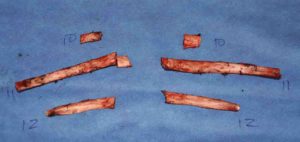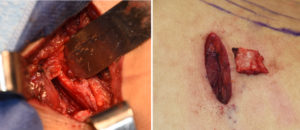Posterior rib removal is the end stage approach to horizontal waistline reduction. It removes the last anatomic barrier to a more narrow waistline after fat reduction by liposuction and muscle contouring by fascial plication in a tummy tuck. It creates this change in waistline profile by virtue of the angulation of the free floating ribs from their vertebral attachments. While often perceived as having a near horizontal or partially oblique orientation, these ribs are a lot more vertical orientation than most think. This places them in direct ‘obstruction’ with a more inward waistline movement.
While rib #s 11 and 12 are the classic free floating ribs and have no distal osteocartilaginous attachments, they are not the only ribs that can affect the waistline. Rib #10 above them also has a waistline effect. For this reason it is often included with rib #s 11 and 12 as part of the overall rib removal approach.
In such rib removal surgery it is important to center the small back incision needed over the middle rib to be removed. (#11) In his way the incisional access can be moved up or down to reach the neighboring ribs. While this works well for rib #12, rib #10 is often more challenging in this regard. Its higher ribcage position and the way it is angled makes it always the more challenging rib to remove. Coupled with the anatomic reality that the pleura of the lung always lies right beneath this rib, consideration of less than an aggressive reception of it comes to mind.

Dr. Barry Eppley
Indianapolis, Indiana



